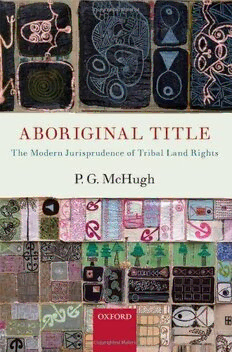
Aboriginal Title: The Modern Jurisprudence of Tribal Land Rights PDF
Preview Aboriginal Title: The Modern Jurisprudence of Tribal Land Rights
ABORIGINAL TITLE This page intentionally left blank Aboriginal Title The Modern Jurisprudence of Tribal Land Rights P.G. MCHUGH ReaderinLawattheUniversityofCambridge andFellowofSidneySussexCollege 1 3 GreatClarendonStreet,Oxfordox26dp OxfordUniversityPressisadepartmentoftheUniversityofOxford. ItfurtherstheUniversity’sobjectiveofexcellenceinresearch,scholarship, andeducationbypublishingworldwidein Oxford NewYork Auckland CapeTown DaresSalaam HongKong Karachi KualaLumpur Madrid Melbourne MexicoCity Nairobi NewDelhi Shanghai Taipei Toronto Withofficesin Argentina Austria Brazil Chile CzechRepublic France Greece Guatemala Hungary Italy Japan Poland Portugal Singapore SouthKorea Switzerland Thailand Turkey Ukraine Vietnam OxfordisaregisteredtrademarkofOxfordUniversityPress intheUKandincertainothercountries PublishedintheUnitedStates byOxfordUniversityPressInc.,NewYork #P.G.McHugh,2011 Themoralrightsoftheauthorhavebeenasserted DatabaserightOxfordUniversityPress(maker) CrowncopyrightmaterialisreproducedunderClassLicence NumberC01P0000148withthepermissionofOPSI andtheQueen’sPrinterforScotland Firstpublished2011 Allrightsreserved.Nopartofthispublicationmaybereproduced, storedinaretrievalsystem,ortransmitted,inanyformorbyanymeans, withoutthepriorpermissioninwritingofOxfordUniversityPress, orasexpresslypermittedbylaw,orundertermsagreedwiththeappropriate reprographicsrightsorganization.Enquiriesconcerningreproduction outsidethescopeoftheaboveshouldbesenttotheRightsDepartment, OxfordUniversityPress,attheaddressabove Youmustnotcirculatethisbookinanyotherbindingorcover andyoumustimposethesameconditiononanyacquirer BritishLibraryCataloguinginPublicationData Dataavailable LibraryofCongressCataloginginPublicationData LibraryofCongressControlNumber:2011933691 TypesetbySPIPublisherServices,Pondicherry,India PrintedinGreatBritain onacid-freepaperby CPIAntonyRowe,Chippenham,Wiltshire ISBN 978–0–19–969941–4 1 3 5 7 9 10 8 6 4 2 For Olivia, Louisa, Frankie, and Andrew This page intentionally left blank Preface The book profiles a transformative court-based jurisprudence that burst into prominence and controversy during the final quarter of the twentieth century (and with which I have been associated as close-quarter witness and sometime participant, though in a minor way). Almost overnight, judicial recognition of common law aboriginal title upturned national politics and gave tribal peoples unprecedentedandimmenselegalleverage.Whilstitwasprimarilyaphenomenon oftheAnglocommonlawjurisdictionsofCanada,Australia,andNewZealand,the emergenceofthecommonlaw—thatistosay,judge-made—doctrineofaboriginal law commanded international attention and influenced the formation of interna- tional law during the 1990s and after as well as spreading to other national legal systems in the new century. This book is an intellectual history of the rise and reception of the doctrine. It traces that emergence from a post-War stalemate in whichAnglo-settlerjurisdictionsfacedthesevereplightoftheirindigenouspeoples andproposedpoliciesoflegalreformbasedonthepolicyofassimilation.Thetribes’ vocalrejectionofthosepolicies,comingintherisingtemperatureofthecivilrights era and courts’ conceptualization of a less deferential role for public law, led to nationalmovementsforstatutorylandrights.Thoselandclaimsencompassednot onlythecallforvastlystrengthenedlegalprotectionofextanttribaluserightsand longstandingcustomarypracticesfromstate-licenseddisruptionbutalsocalledfor statemeasuresofrestitutionandrecompenseforlandshistoricallytakenbycolour- able means. Common law aboriginal title was the courts’ response to the political branches’slowreactionto,indeedinactionon,thoselandclaims.Itfirstappeared inwesternCanadaduringthe1970sasanunformedlegalargument,butprogres- sivelytookwiderrootreceivingfulleracademicattentionandameasureoftraction insomenationalcourts.Bythe1980stherewasagroundswellofscholarshipand deepening intellectual acceptance of the doctrine, which set the stage for the breakthroughjudgmentsofpeakcourts.Toimmensecontroversyandgovernment unease, these judgments (chiefly in the decade spanning the mid-1980s to mid- 1990s) recognized aboriginal title as a proprietary interest cognizable at law and enforceableagainsttheCrown.Almostovernight,thecourts’wholeheartedaccep- tance of the doctrine changed the tribes’ terms of engagement with governments who,untilthen,hadbecomeaccustomedtowhattheyperceivedastheembedded legal position by which those relations had been a non-justiciable ‘political trust’. Suddenly the tribes’ land claims had legal propulsion, and addressing them accel- erated up the national agendas withsudden urgency. From that breakthrough era there formed,especially in Canada andAustralia, national jurisprudences of com- monlawaboriginaltitle. The book opens (Chapter 1) with a general historical outline of the post-War legalism surrounding tribal peoples. It then gives (Chapter 2) an account of the intellectualprovenanceofthedoctrineleadingtothebreakthroughcasesinthekey viii Preface jurisdictions of (in order of reception) Canada, New Zealand, and Australia. Chapter 3 looks at the subsequent pathways of doctrinal development in the most prominent and busiest jurisdictions, Canada and Australia, noting how, as the case-law developed, the courts resiled from their early interventionism. The patternofjudicialevolutionofaboriginaltitlebecamemorecautiousascourtsfilled in the detail of the property right. The early boldness was replaced by more constrained, indeed constrictive, judicial reasoning. Chapter 4 looks at what happened meanwhileandas that municipal detailingoccurred through the 1990s andintothenewcentury:boostedbythathigh-profiledomesticlegalism,interna- tionallawdevelopedacloserinterestinindigenouspeoplesasdistinctrights-bearers holdinglandandterritorialrights.Asthisinternationalattentiongrew,increasingly tribes wrapped the cluster of rights that had come to be termed adjectivally as ‘aboriginal’ in the more politicized master-right of autonomy and self-determina- tion.Nonethelessland,andassociatedissues,remainedattheheartoftheirclaims. In the new century, aboriginal title surfaced in fraternal jurisdictions of Africa, Belize, New Zealand (dramatically resurgent), and Malaysia as well as rippling to otherlegalsystems,showingagainitscapacitytodiscomfortgovernmentsandspark controversy(inanerawherehumanrightsmonitoringbodiesaugmentedmunici- pallegalism).Finally,Chapter5considersthedisciplinarypracticesthatintersected withcommonlawaboriginaltitleandthatweredrawnintoitslegalism,especially anthropology and history. These disciplines not only gave important evidentiary inputtothelegalprocessesbutalsotheirinvolvementrequiredtheirpractitionersto address fundamental questions of professional method and ostensible claims to detachedobjectivity,particularlythosearisinginanadversarialsetting.Thearrival ofaboriginalrightsalsoattractedmajorpoliticalphilosopherswhosoughttojustify or critique those national processes of land-rights recognition, reparation, and the widerimplicationsofconstitutionalandlegalclaimsthatwerenowbeingprefaced andpresentedasaboriginalincharacter. Fewlegaldoctrineshavehadsuchamajorimpactonthecutofnationalpolitics ascommonlawaboriginaltitle:itstartedasanidea,onethatspread,andasittook hold,shookthenationallegalsystemsintoaneweraofdialogueandaccommoda- tion.Theadjustmentwasnotaneasyorgood-temperedone.Itbecameafumbling andinsomewaysfetishisticjurisprudencepreoccupiedwith(andsocompromised by)itsadversarialmannerofbirthandthegeneticimprintofaproprietaryright.It spawned explosively from a notion of the national common law, the intellectual appealofwhichseguedintootherlesscontroversialjuridicalfoundations(notably theNativeTitleAct1993inAustralia,and,inCanada,section35oftheConstitu- tionAct1982).Itwastheoutsetofwhatbecamearampantlegalism(‘lawfare’)that boundedintoandnowricochetswildlyaboutmosttribes’affairs.Itmademodern legalhistory.Itisstillmakingit. Iopenandclosethebookwithanacknowledgementofthestrugglesofindige- nouspeoplesbefore,during,andaftertheadventofaboriginaltitle;butIalsostress that this book is not a history inside their culture and those struggles (and beside whichthisnarrativedimsconsiderably).Rather,itisanaccountofhowinthelast quarter of the twentieth century Anglo intellectualism, its legalism especially, Preface ix absorbed and responded to the tribes’ plight. This book is set in the house of whitefella’sthought.Whenthecourtsusedcommonlawaboriginaltitletoseizethe initiative and break the irresolution of the political branches, the tribes’ relations with the state took what seemed an important and positive turn. Those relations werenowtobeframedinthelanguageoflawwheretribeswererights-bearersinside aproprietaryparadigm.Gone,or ratherdisappearing,wasthevaguenessofunfet- teredexecutivediscretioninaneweraofcourt-monitoredrelations.Thatturnwas no bad thing (compared to what had gone before), but the jury is still out on whetheritisandwhatitbroughtwasagoodthing. Thisbookisaconventionalintellectualhistoryinthatitfollowstheemergenceand lifetime (to date) of common law aboriginal title in a mostly chronological manner. Ihavetriedtokeepthenarrativeinthetextasdirectaspossible,althoughthefootnotes areample,bristlingwithsub-issuesandsmallerbushfires.Ihavestatedthelaw,asfaras Ican,to31August2010,althoughrevisionhasallowedsomeupdatinginplaces. Thisbookhasbeenwrittenbothasatributetoandcritiqueofthecommonlaw enterprise.Itiswrittenbothasparticipantandobserver,andasapersonaltributeto those who have been on this journey for as long as me or, indeed, in some cases, longer. A few who particularly shaped my own thinking, sadly, have left us: including my father, Judge AG ‘Chick’ McHugh; the inspirational Lord Robin Cooke(whoshowedimmensekindnesstomeasayoungscholarinthe1980s);the heroicMichaelTaggartatatragicallyyoungage;theprairiesagesRogerCarterQC, urbane and kind, plus Howard McConnell, compassionate raconteur; and the dogged ‘Jock’ Brookfield, all generous in their encouragement and disagreement andcommonlawyersintheirsinewsandtotheirmarrow. In the legal quarters in which I circulated from the very early 1980s, a new golden jurisprudence—or national series of them—seemed to be dawning. That decade seemed ripe with potential. It is impossible to write a history of common lawaboriginaltitlewithoutstressingthatsenseofhighexpectationandrecapturing elements of one’s own youth. I was lucky enough to be at a particular place—the CollegeofLawintheUniversityofSaskatchewan1980–81—wheretheintellectual fervourwasconsiderableandwheremajorfigureswereattheoutsetoftheircareers (Brian Slattery—my inspirational LLM supervisor who for over thirty years has commanded this field with deep scholarship and compassion—and Kent McNeil especially, alongside others including Richard Bartlett, Howard McConnell, and Eric Colvin). In the two decades that followed those hopes were less dashed than dowsed with greater realism and apprehension of the inherent limitations of the adjudicativeprocess.Toomuchhadbeenhopedfor,thecourtshadbeenoverladen withanexpectationonwhich,inretrospect,theycouldneverhavedelivered.These constraints were plain by the millennium and after a decade of judicial cogitation and decision-making fleshing out the proprietary paradigm, accompanied as that was by sideline coaching andbarracking from the academics, journalists, activists, and others with strong opinions on what the courts should—or should not—be doing. As court intervention became a new feature of the political landscape of tribes’ relations with governments, attitudes formed as to its effectiveness. Some remained starry-eyed about the potential, seeing judicial activity in a Dworkinian
